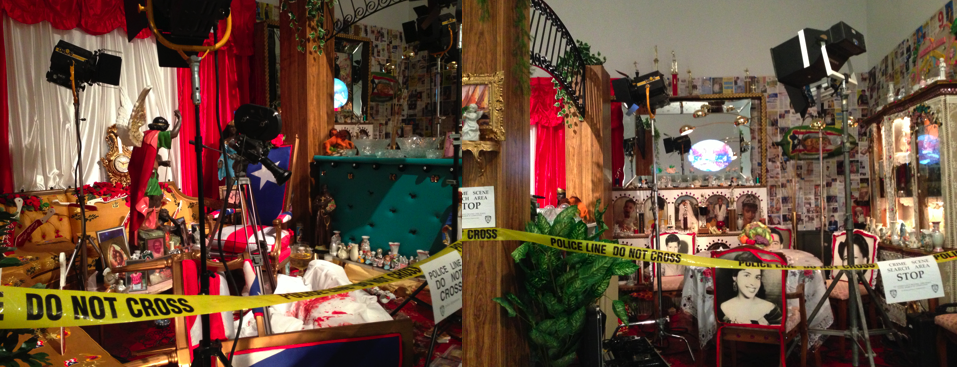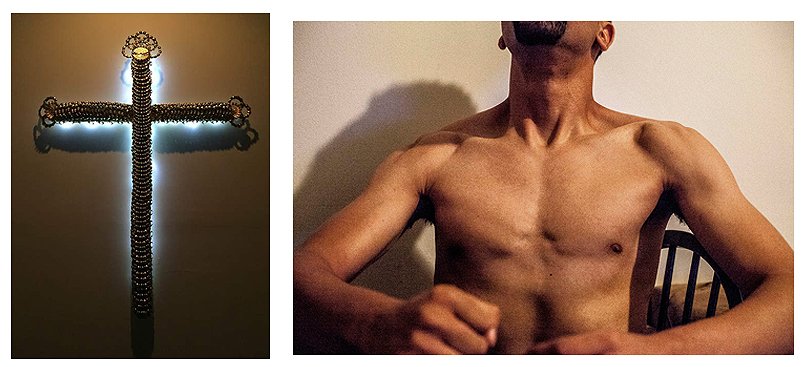
Beautiful by Ron Kavanaugh
Everything has beauty, but not everyone sees it. –Confucius
You hear the rhetoric –the Bronx is beautiful—but in the midst of the 70s it seemed other. When the borough was branded as the center of all things nihilist –fires, crime, and abandonment– the assiduous immolation consumed all things beautiful.
It was the artist Pepón Osorio, an AfroLatino Puerto Rican, who migrated to the Bronx in 1975, that best connected me to the idea that my world of catastrophes could be elevated to beauty. Osorio is best known for his large-scale installation –often encompassing several rooms—that utilize domestic and community items reworked into multimedia exhibits, which explore political and cultural issues in specific communities that incorporate multiple disciplines: photography, silkscreen, video, and sound. What I wrote-off as mundane, Pepón reassembled into beautiful altars to Bronx and Latino lives and folklore. Osorio, respecting no single form, idolatry, or practice, codifies and repurposes urban narratives presenting installations that celebrate and examine ourselves. All of this serves as a metaphor for the Bronx.
 Pepón Osorio, Scene of the Crime (Whose Crime?) 1993
Pepón Osorio, Scene of the Crime (Whose Crime?) 1993
What Pepón’s installations eloquently make viable can be seen in the burgeoning arts scene in the Bronx. An avant garde of disparate elements and influences randomly forming a movement centered, for the most part, in the South Bronx. Since 2010, several community based arts initiatives have launched. The Bronx Music Heritage Center presents music and visual art programs that reflect the history of the borough; Wallworks (spearheaded by graf legend John “Crash” Matos) is a new contemporary art gallery on Bruckner Blvd.; Bronx Documentary Center curates photography, film and new media exhibits; and BXArts Factory has as its mission the goal of increasing access to the arts in the Bronx. It’s the variety of ideas and practices –photography, painting, music, sculpture, graffiti, and performance– supported with different forms of pedagogy that make this movement feel grounded and uniquely South South Bronx.
 John Ahearn, Mirror for Andrew Glover | John “Crash” Matos, Untitled
John Ahearn, Mirror for Andrew Glover | John “Crash” Matos, Untitled
But of all these nascent organizations, it is BX200 Bronx Visual Artist Directory, BX200.com, that is the most expansive. This web-based initiative, which launched in March 2015, provides primarily a digital space for almost 200 Bronx-based visual artists to present work, cultivate interest, and publicize future endeavors –a digitized Carl Van Vechten without the cultural commoditization and appropriation. Each listed artist has a page on which to showcase a photo array, artist’s statement, and bio. Prior to its launch many of these artists worked in isolation, not realizing that their neighbors were also artists –not realizing that their neighbors may also be buyers. Artists were disconnected from shared professional development and cooperative exhibit opportunities that a greater reach can offer. Since the digital launch, BX200 has presented a series of mixed-media artist’s talks at a variety of traditional and alternative art spaces throughout the Bronx and, last September, curated their first exhibit at BronxArtSpace Gallery.
What BX200 illuminates is that the artist cannot solely represent him or herself. There are physical, digital, and social media venues providing agency that can be leveraged to connect the artist, and offer, through exposition, a place to engage audience with accessible information about their practice and break the cycle where creativity and isolation often conspire to keep an artist from the most important ingredient of engagement.
Bronx Now, an exhibit that features a curated selection of 30 artists, is their first interborough class trip and serves as a marker in the development of the unified Bronx arts scene. The temporary transference from the BX to Bushwick will reinforce that no scene or movement can be wholly realized by remaining insular. Movements are actively nurtured by accessing a variety of ideas and modalities. The artists featured in Bronx Now are here because they know that art is borderless. Artists seek inputs that replenish creativity and energy, wherever they are.
 Melanie Gonzalez, Door Knocker Altar Cross | Danny R Peralta, from ‘Bout That Life
Melanie Gonzalez, Door Knocker Altar Cross | Danny R Peralta, from ‘Bout That Life
I’m sure this exhibit will generate short-sighted critiques in regards to a collective of Bronx artists leaving home. Fingers will wag –this is a collective exodus that may represent the Bronx but will potentially exacerbate development. In actuality that’s not how the cycle works. In spite of this necessary exhibit, the gentry have long ago plowed through Bushwick, into Harlem, and are steadily making their way into the Bronx. The grit that once inoculated these brown utopias, forming a Caucasian-proof ring around them has eroded. Crime ramparts have fallen. What remains is the beautiful art that has always existed in these communities and can now be freely exported. And artists who have faced north with equal parts desire and fear are now free to come to the Boogie Down to be influenced and to influence.
Ron Kavanaugh is a lifelong resident of the Bronx. He is editor and publisher of Mosaic Literary Magazine, executive director of the Literary Freedom Project, and social media manager at the Bronx Museum of the Arts.




Troy Johnson
Thanks for introducing me to the work of the artist Pepón Osorio